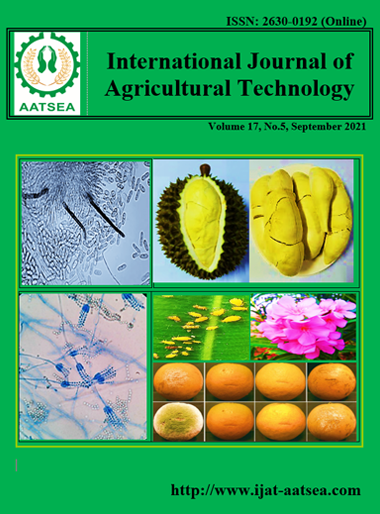Effects of N and P dosages on crop growth, yield, and attack of pod borrer (Etiela zinchenella) of soybean c.v. Detam-1 grown at swampy land
Main Article Content
Abstract
Soybean (Glycine max (L.) Merr.) is one of the best protein sources for Indonesians. However, the national soybean production does not meet the demand due to the low crop productivity, which causes major pests and poor soil nutrients. The best rate of N and P in promoting crop growth was investigated to get maximum yield, and minimize pod borer attacked by Etiela zinchenella on soybean c.v. Detam 1. The results showed that the interaction of N and P significantly affected the number of leaves, the number of pods produced, and the percentage of pod attached by pod borer. We concluded that the interaction between 25 kg.ha-1 Urea + 100 kg.ha-1 TSP showed the best growth, the highest yield, and the lowest percentage of pod attacked by pod borer
Article Details

This work is licensed under a Creative Commons Attribution-NonCommercial-NoDerivatives 4.0 International License.
References
Apriyanto, D., Yoga, O. H. and Mulyadi, A. (2009). Performance of soybean pod borer, Etiella zinckenella Treitschke (Lepidoptera: Pyralidae), and host preference on soybean and groundnut. Akta Agrosia, 12:62-67.
Chozin, M., Silalahi, S., Masdar and Sumardi (2019). Agronomic Performances of Rice Lines on Non-Tidal Swampland. Akta Agrosia, 22:1-6.
Fabre, F. and Planchon, C. (2000). Nitrogen nutrition, yield, and protein content in soybean. Plant Science, 152:51-58.
Hanafiah, A., Anas, I., Napoleon, A. and Ghofar, A. (2005). Soil Biology. Jakarta, Raja Grafindo Persada.
Indiati, S. W. and Marwoto (2017). Application of Integrated Pest Management (IPM) on Soybean. Buletin Palawija, 15:87-100.
Krisnawati, A. and Adie, M. M. (2015). Variability of Biomass and Harvest Index from Several Soybean Genotypes as Renewable Energy Source. Energy Procedia, 65:14-21.
Marwoto and Saleh, N. (2003). Increasing the Role of the Egg Parasitoid Trichogrammatoidea bactrae-bactrae in the Control of the Soybean Pod Borer Etiella spp. Research Institute for Legumes and Tubers. Journal of Agricultural Research and Development, 22:141-149.
Mulyaningsih, L. (2017). Effect of urea fertilizer use on brown ladybug (Riptortus linearis Fabricius) attack on soybean (Glycine max L.). AGRI-TEK: Journal of Agricultural Sciences, Forestry, and Agrotechnology, 18:30-35.
Prakoso, D. I., Indradewa, D. and Sulistyaningsih, E. (2018). Effect of urea fertilizer rates on growth and yield of soybean (Glycine max L. Merr.) cv. Anjasmoro. Vegetalika 7:16-29.
Rahayu, M., Bande, L. O. S., Hasan, A., Yuswana, A. and Rinambo, F. (2018). Contribution of pod borer pests to soybean crop production (case in Pondidaha, Konawe District, Southeast Sulawesi). International Conference on Agriculture, Environment, and Food Security. IOP Publishing, 122 p.
Salvagiotti, F., Cassman, K. G., Specht, J. E., Walters, D. T., Weiss, A. and Dobermann, A. (2008). Nitrogen uptake, fixation and response to fertilizer N in soybeans: a review. Field Crop Research, 108:1-12.
Simarangkir, J. R. (2000). Effect of planting season, rice stem borer attack and fertilization (Urea, TSP, and KCL) on rice productivity in West Java. (Master Thesis). IPB University, Bogor.
Sumarno and Manshori. A. G. (2013). Persyaratan tumbuh dan wilayah produksi kedelai di Indonesia. Kedelai: Teknik Produksi dan Pengembangan, pp.74-103.
Sutristo., Wahyuningsih, S. and Baliadi, Y. (2020). Effectiveness of three soybean cultivation technology packages applied in tidal swamp land of Barito Kuala, South Kalimantan. Buletin Palawija, 18:11-19.
Untung, K. (2000). Institutionalization of integrated pest control in Indonesia. Jurnal Perlindungan Tanaman Indonesia, 6:1-8.
Willis, M., Najib, M. and Prayudi, B. (2003). Hama utama kedelai dan alternatif pengendaliannya di lahan pasang surut Repositori Publikasi Kemeterian Pertanian 18-32. Retrieved from http://repository.pertanian.go.id/handle/123456789/8622
Wood, C. W., Reeves, D. W. and Himelrick, D. G. (1993). Relationship between chlorophyll meter reading and leaf chlorophyll, N status, and crop yield: A Review. Proceeding Agronomy Society of New Zealand.


